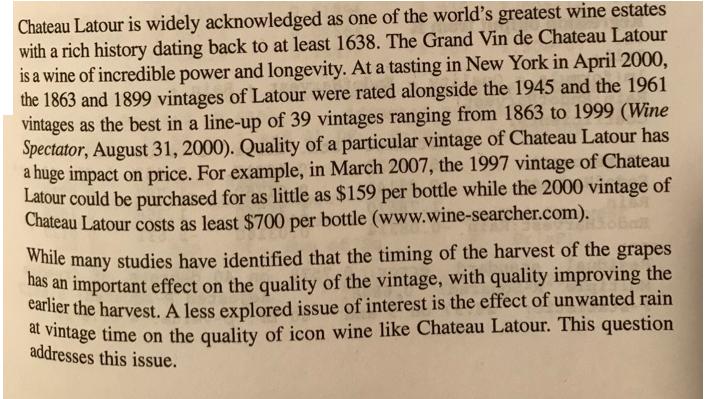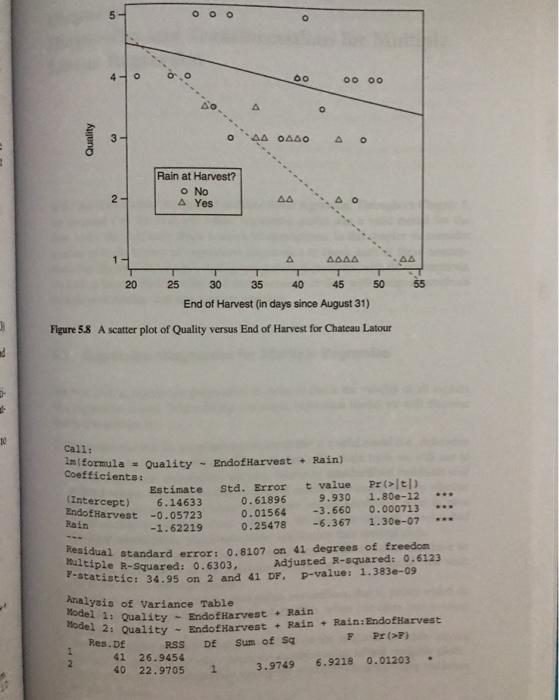Answered step by step
Verified Expert Solution
Question
1 Approved Answer
Chateau Latour is widely acknowledged as one of the world's greatest wine estates with a rich history dating back to at least 1638. The



Chateau Latour is widely acknowledged as one of the world's greatest wine estates with a rich history dating back to at least 1638. The Grand Vin de Chateau Latour is a wine of incredible power and longevity. At a tasting in New York in April 2000, the 1863 and 1899 vintages of Latour were rated alongside the 1945 and the 1961 vintages as the best in a line-up of 39 vintages ranging from 1863 to 1999 (Wine Spectator, August 31, 2000). Quality of a particular vintage of Chateau Latour has a huge impact on price. For example, in March 2007, the 1997 vintage of Chateau Latour could be purchased for as little as $159 per bottle while the 2000 vintage of Chateau Latour costs as least $700 per bottle (www.wine-searcher.com). While many studies have identified that the timing of the harvest of the grapes has an important effect on the quality of the vintage, with quality improving the earlier the harvest. A less explored issue of interest is the effect of unwanted rain at vintage time on the quality of icon wine like Chateau Latour. This question addresses this issue. The Chateau Latour web site (www.chateau-latour.com) provides a tich source of data. In particular, data on the quality of each vintage, harvest dates and weather at harvest time were obtained from the site for the vintages from 1961 to 2004. An example of the information on weather at harvest time is given below for the 1994 vintage: Harvest began on the 13th September and lasted on the 29th, frequently interrupted by storm showers. But quite amazingly the dilution effect in the grapes was very limited... (http://www.chateau-latour.com/commentaires/1994uk.html"; Accessed: March 16, 2007) Each vintage was classified as having had "unwanted rain at harvest" (c.g., the 1994 vintage) or not (e.g., the 1996 vintage) on the basis of information like that reproduced above. Thus, the data consist of: Vintage = year the grapes were harvested Quality - on a scale from 1 (worst) to 5 (best) with some half points End of harvest - measured as the number days since August 31 Rain a dummy variable for unwanted rain at harvest = 1 if yes. The data can be found on the book web site in the file latour.csv. The first model considered was: (5.10) A plot of the data and the two regression lines from model (5.10) can be found in Figure 5.8. In addition, numerical output appears below. Quality = B, + B, End of Harvest + B, Rain + B, End of Harvest x Rain + e (a) Show that the coefficient of the interaction term in model (5.10) is statisti- cally significant. In other words, show that the rate of change in quality rat- ing depends on whether there has been any unwanted rain at vintage. (b) Estimate the number of days of delay to the end of harvest it takes to decrease the quality rating by 1 point when there is: (i) No unwanted rain at harvest (ii) Some unwanted rain at harvest Regression output from R Call: 1m (formula = Quality - EndofHarvest+ Rain Rain: Endof Harvest) Coefficients: Estimate 5.16122 -0.03145 1.78670 EndofHarvest: Rain -0.08314 (Intercept) EndofHarvest Rain Std. Error t value Pr(>/t/) 0.68917 7.489 3.95e-09 0.01760 -1.787 1.31740 0.03160 1.356 -2.631 standard error: 0.7578 Residual Multiple R-Squared: 0.6848, 28.97 on 3 and F-statistic: www 0.0816- 0.1826 0.0120. on 40 degrees of freedom Adjusted R-squared: 0.6612 40 DF, p-value: 4.017e-10 nd 10 Quality 5 4-0 Rain 3 2 27 20 6 Rain at Harvest? o No A Yes 0 25 (Intercept) 6.14633 EndofHarvest -0.05723 -1.62219 A 60 AA 0440 41 26.9454 40 22.9705 44 30 35 40 45 End of Harvest (in days since August 31) Figure 5.8 A scatter plot of Quality versus End of Harvest for Chateau Latour A Call: Im(formula = Quality - EndofHarvest + Rain) Coefficients: 1 Analysis of Variance Table Model 1: Quality - EndofHarvest Rain Model 2: Quality - Endof Harvest Res.DE RSS Df Sum of Sq O D 00 00 AAAA 3.9749 O Estimate Std. Error t value Pr(> [t]) 0.61896 9.930 1.800-12 -3.660 0.01564 0.000713 0.25478 -6.367 1.30e-07 50 Residual standard error: 0.8107 on 41 degrees of freedom Multiple R-Squared: 0.6303, Adjusted R-squared: 0.6123 F-statistic: 34.95 on 2 and 41 DF. p-value: 1.383e-09 44 55 Rain + Rain: EndofHarvest F Pr (>P) 6.9218 0.01203
Step by Step Solution
★★★★★
3.45 Rating (164 Votes )
There are 3 Steps involved in it
Step: 1

Get Instant Access to Expert-Tailored Solutions
See step-by-step solutions with expert insights and AI powered tools for academic success
Step: 2

Step: 3

Ace Your Homework with AI
Get the answers you need in no time with our AI-driven, step-by-step assistance
Get Started


